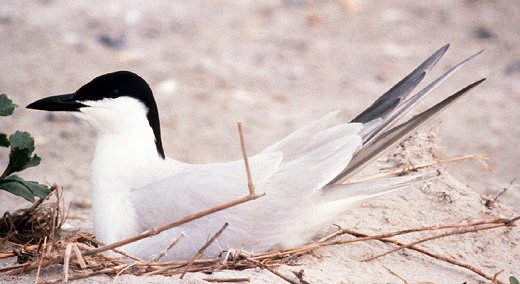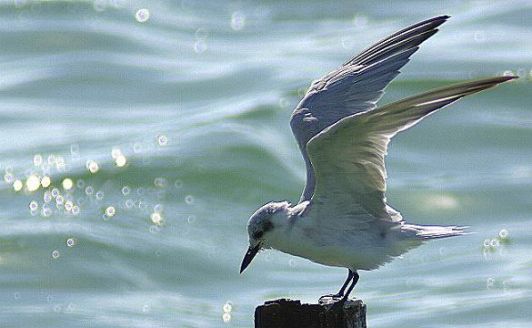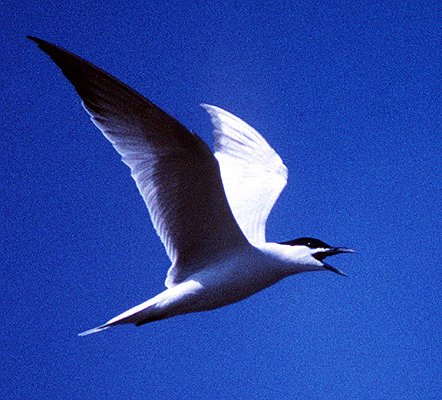| Gull-billed Tern
Sterna nilotica Charrán Piquigrueso |
 |
|
Photo: J. Parnell
|
| Gull-billed Tern
Sterna nilotica Charrán Piquigrueso |
 |
|
Photo: J. Parnell
|
|
IDENTIFICATION: A relatively short, thick bill distinguishes this black-capped tern from its relatives. Length: 33-38 cm.; weight: 150-184 g. VOICE: A low-pitched squawk. Audio (M. Oberle). HABITAT: Coastal mudflats, ponds, lagoons, marshes and flooded fields HABITS: Unlike other terns that feed mostly on fish, this species also plucks insects, crabs and chicks of other birds from the ground, and will hawk insects in the air, like a swallow. On the breeding grounds, both sexes prepare a nest scrape on a protected sandy beach, often near other tern species. Both parents incubate the 3-4 eggs for 22-23 days and then brood and feed the young. Chicks often wander away from the nest where they are sometimes attacked by neighboring terns. The chicks fledge 28-35 days after hatching but often stay with the parents during migration. The Gull-billed Tern migrates south to Panama and sometimes South America after breeding. A Gull-billed Tern banded in Virginia was once recovered in Puerto Rico. STATUS AND CONSERVATION: An uncommon visitor to Puerto Rico, mostly in summer months. This species was threatened by commercial hunting for its feathers a century ago. Current threats include disturbance of nesting colonies. Some birds have begun to nest on flat rooftops to escape disturbance. The breeding population in the West Indies is estimated at 100-500 pairs. RANGE: Breeds along the coast in southern North America, the Bahamas and parts of the Old World, and has bred in the Virgin Islands. Occasionally reported from the Cabo Rojo salt flats. TAXONOMY: CHARADRIIFORMES; LARIDAE; Sterninae |
 |
|
Photo: A. Sánchez Muñoz
|
 |
|
Photo: B. Hallett
|
 |
|
Photo: B. Hallett
|
 |
|
Photo: G. Beaton
|
|
References Bent, A.C. 1921. Life histories of North American gulls and terns. Smithsonian Instit. U.S. National Museum Bull. 113. (Reprinted by Dover Press, 1963). Chardine, J. W., R. D. Morris, J. F. Parnell, and J. Pierce. 2000. Status and conservation priorities for Laughing Gulls, Gull-billed Terns, Royal Terns and Bridled Terns in the West Indies. Pp. 65-79 in Status and conservation of West Indian seabirds (E. A. Schreiber and D. S. Lee, eds.). Soc. Carib. Ornith., Special Pub. No. 1. del Hoyo, J., A. Elliott, and J. Sargatal, eds. 1996. Handbook of Birds of the World, Vol. 3. Hoatzin to Auks. Lynx Edicions, Barcelona. Parnell, J. F., R. M. Erwin, and K. C. Molina. 1995. Gull-billed Tern (Sterna nilotica). No. 140 in The birds of North America (A. Poole and F. Gill, eds.). Acad. Nat. Sci., Philadelphia, PA, and Am. Ornithol. Union, Washington, D.C Pérez-Rivera, R.A. 1980. Algunas notas sobre migración de aves en Puerto Rico. Science-Ciencia 7(4):123-126. Raffaele, H.A. 1989. A guide to the birds of Puerto Rico and the Virgin Islands. Princeton. Raffaele, H.A. 1989. Una guía a las aves de Puerto Rico y las Islas Vírgenes. Publishing Resources, Inc., Santurce, PR. Raffaele, H.A., J.W. Wiley, O.H. Garrido, A.R. Keith, and J.I. Raffaele. 1998. Guide to the birds of the West Indies. Princeton. Schreiber, E. A. and D. S. Lee. 2000. West Indian seabirds: a disappearing natural resource. Pp. 1-10 in Status and conservation of West Indian seabirds (E. A. Schreiber and D. S. Lee, eds.). Soc. Carib. Ornith., Special Pub. No. 1. Schreiber, E. A. 2000. Action plan for conservation of West Indian seabirds. Pp. 182-191 in Status and conservation of West Indian seabirds (E. A. Schreiber and D. S. Lee, eds.). Soc. Carib. Ornith., Special Pub. No. 1. Wiley, J. W. 2000. A bibliography of seabirds in the West Indies. Pp. 192-225 in Status and conservation of West Indian seabirds (E. A. Schreiber and D. S. Lee, eds.). Soc. Carib. Ornith., Special Pub. No. 1. Gull-billed Tern, Spanish text Next related species in taxonomic order Previous related species in taxonomic order |